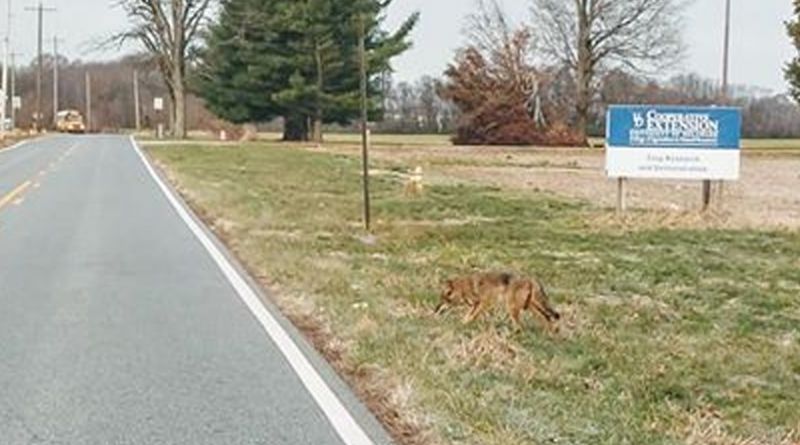When we received a photograph of what appears to be a coyote near a University of Delaware sign it caught our attention.
[media-credit name=”Photos Courtesy Lou Perna – Taken in December” align=”aligncenter” width=”800″] [/media-credit]
[/media-credit]
The image, now images, depicts an animal that appears to be a coyote walking in the area of the UD Coop Extension on Marl Pit Road in Middletown.
In addition to the photo, we learned that several people have also taken to Nextdoor to report coyote sightings near Lums Pond, White Clay Creek SP, Paper Mill Road, and Cover Bridge Farms.
While not common, documented coyote sightings are not new in any of Delaware’s three counties, according to Department of Natural Resources and Environmental Control’s (DNREC) website.
Canis latrans (coyote) now makes its habitat in all states except Hawaii, and they have been spotted in Delaware both north and south of the C&D Canal.
The state’s coyote population is small but confirmed via photos from trail cameras, occasional animals struck and killed by vehicles, sightings from the public and reports of harvested coyotes. In n 2013 DNREC reported that Delaware’s coyote population was estimated at 50 to 100.
Coyotes may be found within all three of Delaware’s counties but encounters tend to be most common in New Castle County, according to the website. In January 2014, a statewide hunting and trapping season was established and to date, there have been three coyotes harvested by Delaware hunters: one in northern New Castle County, and two in Sussex County.
In spite of being hunted and trapped for more than 200 years, more coyotes exist today than when U.S. Constitution was signed. Hardly any animal in America is more adaptable to changing conditions–the coyote can live in deserts, swamps, tundra, grasslands, and dense forests, from below sea level to high mountains. They have now learned to live in suburbs and cities too.
One of the keys to the coyote’s expanding existence is its diet. A true scavenger, the coyote will eat just about anything. Identified as a killer of sheep, poultry and deer, the coyote will also eat snakes and foxes, rodents and rabbits, fruits and vegetables, birds, frogs, grass and grasshoppers, pet cats and cat food, pet dogs and dog food, carrion, and just plain garbage. Coyotes are active mainly during the nighttime, but they may move about at any time during the day.
DNREC’s website recommends taking the steps below to decrease coyote encounters in areas where they have been sighted. However, coyotes are adaptable to change and quick to learn new ways of survival. By making life less endurable for coyotes in your area, you can increase the likelihood that they will go somewhere else.
Do not feed coyotes, and eliminate standing sources of water for them.
Elevate bird feeders so that coyotes can’t get at them. Coyotes are attracted by bread, table scraps, and even seed. They may also be attracted by birds and rodents that come to the feeders.
Do not discard edible garbage where coyotes can get to it. Also: secure garbage containers.
Don’t allow pets to run free. Keep them safely confined and provide secure nighttime housing for them.
Discourage coyotes from “cohabitating” with humans. If you see them around your home or property, chase them away by shouting, making loud noises, or by throwing rocks at them.

